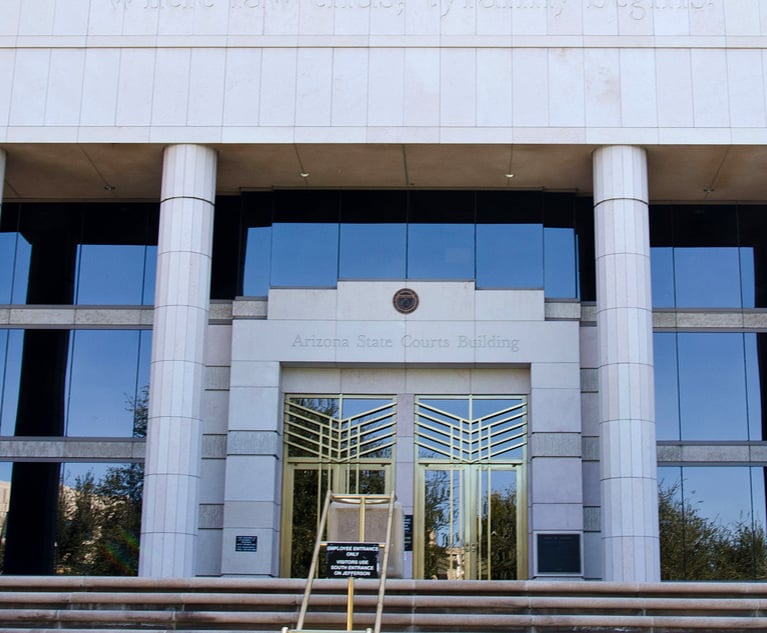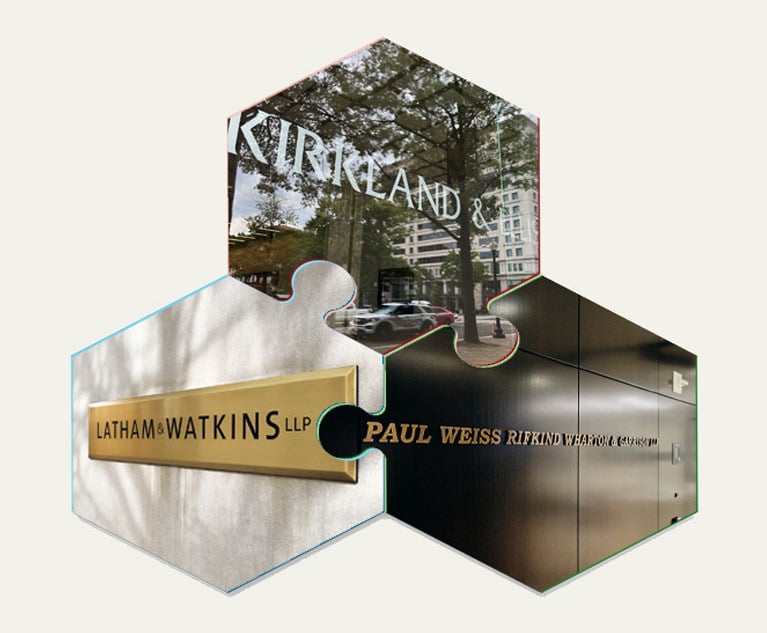D.C.-Based Firms Find Fertile Ground in the Swamp
No Second Hundred firm in Washington saw its partner profits dip last year.
May 22, 2018 at 09:38 AM
4 minute read
 The White House and Lafayette Square in Washington, D.C.
The White House and Lafayette Square in Washington, D.C.
The Washington, D.C., legal market capitalized on America's thriving economy and the uncertainty wrought by President Donald Trump's government to boost revenue last year.
 Dive into the Am Law 200 data and personalize it based on your firm, peers and trends. Learn More
Dive into the Am Law 200 data and personalize it based on your firm, peers and trends. Learn MoreAmong firms ranked in the Second Hundred, Arent Fox, Buckley Sandler and Wiley Rein all showed revenue growth, while Finnegan, Henderson, Farabow, Garrett & Dunner effectively stayed flat—slipping 0.2 percent and falling two places in this year's rankings to 107.
No Second Hundred firm in Washington saw its partner profits dip last year, with Arent Fox leading the way yet again. The firm has grown its profits each and every year since 2009, and its financial performance across the board has the firm creeping closer toward the top 100—moving up four spots to 109 this year.
D.C. mainstays in the Am Law 100 performed even stronger in terms of revenue growth in 2017. Covington & Burling, Williams & Connolly and Venable all saw climbing revenues and all rose in the rankings, while Wilmer Cutler Pickering Hale and Dorr and Akin Gump Strauss Hauer & Feld recorded strong performances once again. Arnold & Porter Kaye Scholer, fresh off the merger of the legacy D.C. firm and its New York counterpart, saw its revenue rise, too.
“I think all of us have been surprised by just how robust the market is,” says Jeffrey Lowe, Major, Lindsey & Africa managing partner in D.C.
Lowe, a leading national recruiter, says the market appeared to be in a holding pattern after Trump's unexpected win, but things began to take off last year.
Philip West, chairman of Steptoe & Johnson, says the regular rhythms of a market tied closely to the federal government have served Washington lawyers well.
“I think D.C. is a stable and strong legal market to be based in,” West says. “We can count on a fair degree of stability and at least industry-matching, if not above-average, growth.”
The highs may not be as high, he suggests, but there's less volatility in comparison to San Francisco, with its focus on the technology sector, or New York, with its reliance on the capital markets and deals. Even as Steptoe fell two slots to 96 in this year's Am Law 100, West says he remains “cautiously optimistic” about the future.
One sign of Washington's healthy market is a counterpoint to that stability: a frenzy of lateral hiring over the last year or so.
 Dive into the Am Law 200 data and personalize it based on your firm, peers and trends. Learn More
Dive into the Am Law 200 data and personalize it based on your firm, peers and trends. Learn MoreEven more than the Trump administration, the volume of lateral partner moves has been the “major disruptive factor” in the D.C. legal market, says Jeff Grossman of Wells Fargo's Legal Specialty Group. Grossman says the pace is at a “greater level than we've ever seen in the past,” with firms also attempting to lure in top talent with higher compensation than ever before.
Partners without a book of business, as is the case with many Washington lawyers and lobbyists who leave government for private practice, are in high demand, too, Grossman notes—especially amid the regulatory, legislative and trade turmoil of the president's first year-and-a-half in office.
Tony Pierce, the partner in charge of Akin Gump's D.C. office, says uncertainty surrounding the new administration drove activity for the firm, and issues of trade, taxation and health care will keep lawyers busy.
Akin Gump, which ranked 29 again on this year's Am Law 100, watched its partner profits soar 13.5 percent, with the firm benefiting from new deals and its lobbying efforts.
Pierce notes that the deregulation brought by the Trump administration has created many new opportunities that Akin Gump is looking to seize. Its offices are set to move from the Dupont Circle neighborhood in 2019, and he says the firm's lobbyists are excited about their new address on K Street, the city's oft-maligned lobbying hub.
“I don't know whether that's a good thing or a pejorative,” Pierce jokes.
This content has been archived. It is available through our partners, LexisNexis® and Bloomberg Law.
To view this content, please continue to their sites.
Not a Lexis Subscriber?
Subscribe Now
Not a Bloomberg Law Subscriber?
Subscribe Now
NOT FOR REPRINT
© 2025 ALM Global, LLC, All Rights Reserved. Request academic re-use from www.copyright.com. All other uses, submit a request to [email protected]. For more information visit Asset & Logo Licensing.
You Might Like
View All
KPMG's Bid to Practice Law in U.S. on Indefinite Hold, as Arizona Justices Exercise Caution

Arizona Supreme Court Presses Pause on KPMG's Bid to Deliver Legal Services

Is It Time for Large UK Law Firms to Begin Taking Private Equity Investment?
7 minute read
Trending Stories
- 1Gunderson Dettmer Opens Atlanta Office With 3 Partners From Morris Manning
- 2Decision of the Day: Court Holds Accident with Post Driver Was 'Bizarre Occurrence,' Dismisses Action Brought Under Labor Law §240
- 3Judge Recommends Disbarment for Attorney Who Plotted to Hack Judge's Email, Phone
- 4Two Wilkinson Stekloff Associates Among Victims of DC Plane Crash
- 5Two More Victims Alleged in New Sean Combs Sex Trafficking Indictment
Who Got The Work
J. Brugh Lower of Gibbons has entered an appearance for industrial equipment supplier Devco Corporation in a pending trademark infringement lawsuit. The suit, accusing the defendant of selling knock-off Graco products, was filed Dec. 18 in New Jersey District Court by Rivkin Radler on behalf of Graco Inc. and Graco Minnesota. The case, assigned to U.S. District Judge Zahid N. Quraishi, is 3:24-cv-11294, Graco Inc. et al v. Devco Corporation.
Who Got The Work
Rebecca Maller-Stein and Kent A. Yalowitz of Arnold & Porter Kaye Scholer have entered their appearances for Hanaco Venture Capital and its executives, Lior Prosor and David Frankel, in a pending securities lawsuit. The action, filed on Dec. 24 in New York Southern District Court by Zell, Aron & Co. on behalf of Goldeneye Advisors, accuses the defendants of negligently and fraudulently managing the plaintiff's $1 million investment. The case, assigned to U.S. District Judge Vernon S. Broderick, is 1:24-cv-09918, Goldeneye Advisors, LLC v. Hanaco Venture Capital, Ltd. et al.
Who Got The Work
Attorneys from A&O Shearman has stepped in as defense counsel for Toronto-Dominion Bank and other defendants in a pending securities class action. The suit, filed Dec. 11 in New York Southern District Court by Bleichmar Fonti & Auld, accuses the defendants of concealing the bank's 'pervasive' deficiencies in regards to its compliance with the Bank Secrecy Act and the quality of its anti-money laundering controls. The case, assigned to U.S. District Judge Arun Subramanian, is 1:24-cv-09445, Gonzalez v. The Toronto-Dominion Bank et al.
Who Got The Work
Crown Castle International, a Pennsylvania company providing shared communications infrastructure, has turned to Luke D. Wolf of Gordon Rees Scully Mansukhani to fend off a pending breach-of-contract lawsuit. The court action, filed Nov. 25 in Michigan Eastern District Court by Hooper Hathaway PC on behalf of The Town Residences LLC, accuses Crown Castle of failing to transfer approximately $30,000 in utility payments from T-Mobile in breach of a roof-top lease and assignment agreement. The case, assigned to U.S. District Judge Susan K. Declercq, is 2:24-cv-13131, The Town Residences LLC v. T-Mobile US, Inc. et al.
Who Got The Work
Wilfred P. Coronato and Daniel M. Schwartz of McCarter & English have stepped in as defense counsel to Electrolux Home Products Inc. in a pending product liability lawsuit. The court action, filed Nov. 26 in New York Eastern District Court by Poulos Lopiccolo PC and Nagel Rice LLP on behalf of David Stern, alleges that the defendant's refrigerators’ drawers and shelving repeatedly break and fall apart within months after purchase. The case, assigned to U.S. District Judge Joan M. Azrack, is 2:24-cv-08204, Stern v. Electrolux Home Products, Inc.
Featured Firms
Law Offices of Gary Martin Hays & Associates, P.C.
(470) 294-1674
Law Offices of Mark E. Salomone
(857) 444-6468
Smith & Hassler
(713) 739-1250










